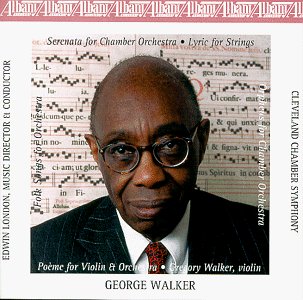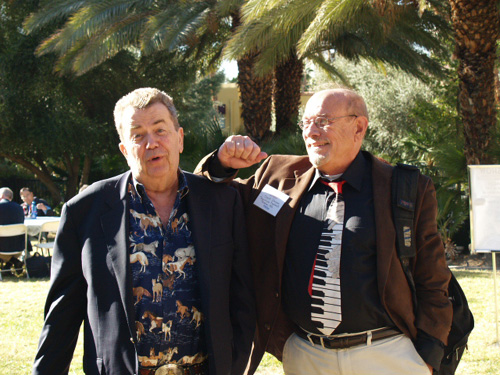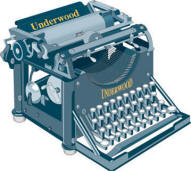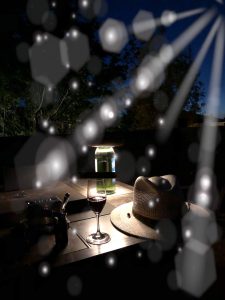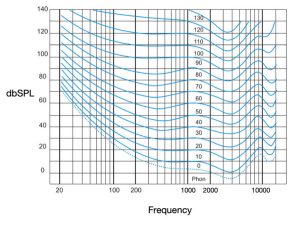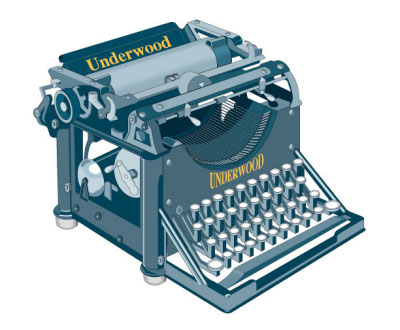
Everyone takes the limits of their own vision for the limits of the world.
– Arthur Schopenhauer
DEDICATION To J. Gordon Holt and Harry Pearson, who regrettably missed out on beholding their own antecedents, which both would have so enjoyed reading.
Our modern times have been blessed with a copious amount of writing about music reproduction. This epoch began in the Fifties and Sixties with the popular magazines Audio, High Fidelity, HiFi, Stereo Review and several British and European periodicals. The American ones no longer exist, or have merged with a new sensibility defining them: video and home theater.
Yet a dedicated readership does still exist for audio, served by niche publications in "the high end," both in print and online now as well. Their readership tends to place great trust in reviews delivered most especially by several veteran writers. But how does one come to discern among their efforts?
Writing ability, along with its enticing entertainment aspect, might seem to be the decisive factor, although that talent does not correlate necessarily with listening ability and musical discernment, both of which are wanted for proper evaluation of audio gear by ear.
But perhaps measurements, as some say, tell a better story? After all, "If it can't be measured, it doesn't exist." As some say. Reports of meter readings require no literary style, no gracious connection to the reader. Once done, that's it. No argument possible. The final word!
Thus arises a defining dichotomy in current audio practice: Shall it be by the numbers, or by the ear?
Nothing new here, so far? Please press on.
Presently in the active high-end segment, the ear is preferred over the meter, although the latter has an acknowledged role. Measurements had formerly gained hegemony both in mass market magazines and the Journal of the Audio Engineering Society (JAES). It took J. Gordon Holt, seemingly, to throw off the shackles with his visionary, disruptive column in the old High Fidelity, "Tested in the Home." He and his approach became successful and hugely influential, but was he really the first?
No, not by a long shot.
There exists a preceding publishing history that even a Google search fails to uncover, at least not with any phraseology of mine. Instead I have researched in person the vast resources of the arts and music collections at the Boston Public Library, where I discovered Phonograph Monthly Review and Disques,published respectively in Boston and Philadelphia. These magazines, dating from as early as 1925, and their coverage of the sound of contemporary recordings and gear, form the basis for this original, albeit derivative article. Who would have thought that audio journalism goes back so far?
The early practice/hobby was not called "audio." It wasn't even called "hi-fi," and the playback machines themselves were variously called phonographs (Edison), gramophones (Berliner) or graphophones (Columbia). Hobbyists were called "gramophiles" and "phonophiles"—in one instance even, "phonograph addicts."
And it's all quite remarkable, really. Much of it reads as though written yesterday!
To begin, behold the humble needle
In the early days needles were easily replaceable, came in two different compositions and numerous brands, and wore out rather quickly (or, they wore the records out). The following listener appraisals appeared in Phonograph Monthly Review (henceforth PMR) for November, 1927:
Though there is clearness in this needle at the same time there is a hardness of tone… The first thing that one notices with the Edison-Bell needle is clearness. Next is smoothness and last but not least a well-balanced, great unity between treble and bass.
I have been a user of the fibre needle for many years, at times using a half-tone steel. Comparing the Euphonic needle with the fibre, one must weigh the wonderful clarity and truth of the former against the almost noiseless and more sonorous reproduction of the latter. It is true the fibre falls considerably behind the Euphonic in regard to definition.
Editor, Phonograph Monthly Review:
Having heard the cry of "Wolf" so often, one has become chary about accepting at face value the claims made for new appliances for the phonograph. The Sympathetic needles and grip which it was my good fortune to obtain from you, may not be all that their makers claim, but from my short experience with them I find them quite superior to any needles I have heretofore used. I intend to use them exclusively from now on, as I have noticed an improvement in tone and less surface noise even when playing badly worn records.
Wareham, Mass. – A. A. Biewend
Editor, Phonograph Monthly Review:
I used the Euphonic needle and grip last evening and am sure they revealed new beauties in my records. They intensified all my old thrills and ecstasies and gave me some new ones. Best of all, they did something to my Brahms Symphony in C minor that broke down the wall between it and my power of appreciation. Boston, Mass. – Thomas A. Watson
The first two are by staff writer Ferdinand G. Fassnacht, the others by enthusiastic correspondents.
And we do still have needles, although they're no longer themselves replaceable. Another crucial component of yesteryear has entirely disappeared: the soundbox. The soundbox was the device that rendered needle motion into an acoustic wavefront via a taut membrane, which then would be amplified by the horn. This unit came in as many varied incarnations as the needles. This modern poster gives some idea of the astounding multiplicity.
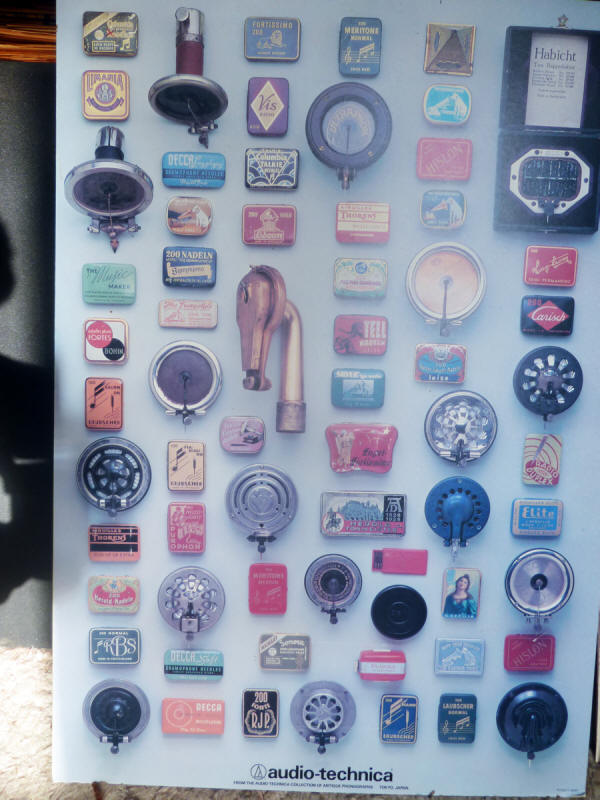
Each make and model had its ardent partisans; there were many imports from Europe; and prices spanned an impressive range. The discussions of soundboxes resemble (pardon me here) our own audio palaver more than anything else of the era. Again, PMR, September, 1927.
Certain British Soundboxes
There are hundreds of soundboxes manufactured in this country. I have specially studied only those in which the diaphragm is not less than 2 9/16 inches in diameter, because this group contains all the boxes capable of reproducing deep bass tone when used on an acoustic system of pleasant open proportion and a horn not more than three feet in length… The steel spring tensioning the stylus bar generally gives acoustic trouble. This box is most likely obtainable in America so I will mention that it may be greatly improved by: (1) Loosening the rubber collar compressing screws at the back so that they only just bite; (2) replacing the corbuscraw [sic] steel tension spring with a tubular spring of rubber; (3) scraping off the paper face label and varnishing the face; (4) chamfering off the sharp edge at the sound outlet from the diaphragm chamber; (5) replacing the mica diaphragm with one of .006 inch aluminum hard spun with stiffening corrugations and mounted so that its edge only is lightly gripped in the gaskets.
There speaks a true hobbyist, one whom today would surely be labeled a tweaker. Unwilling to live with only what was available off-the-shelf, he undertook modifications of his own devising. And how did he know what worked best? How? How?
Anyway, I used to read the first part of the above review out loud to the several audio clubs I have addressed. (Publishing this means I must forego any future pleasure in this regard.) I did not indicate to them the source or the date and carefully omitted any giveaway words. I simply asked the audience to guess the provenance and identity of the D.U.T. Most folks guessed "cartridges," which is close, but no one came even close to the correct date or device.
Moving right along
I hope this old material beguiles everyone else as much as it does myself. I read it again and again for amusement and refreshment. Now here are some further quaint appreciations and lavish encomia to enjoy:
Gramophonic reproduction will always remain an illusion, I suppose. No sane gramophile—if I may borrow Mr. Mackenzie's coined word—should, at any rate, hope for more. But he should satisfy himself, at least, that he is getting the most convincing illusion possible. Fibre [needle] enthusiasts—whose misdirected energy seems to lead them to study record wear rather than musical result—will, no doubt, continue to revel in spineless reproduction of the masterpieces. But the steel needle man, the man who delights in the bite of the strings and is unafraid of the roar of the brass, is fast nearing the attainment of a convincing illusion. I am on the verge of it myself, and with the aid of one of the finest reproducing mediums available, am already able to sit back and sigh contentedly at the realism of electrical recording… American gramophiles are indeed in an envious position when it comes to reproduction media, for with present day machines 75% of English enthusiasts have no idea what their records really contain [!! / CJ]… To revert to the Orthophonic once more, or to any model of similar calibre for that matter, it will be found that a considerable improvement may be effected by the addition of hollow wooden feet or stands. These should be conical in shape; they not only increase sonority and incidentally, with advantage, raise the point of tone-emission, but add to the appearance of the instrument. H.L.Wilson, (senior editor), PMR, November 1927
The newer processes have brought these things to pass. It was so conservative and exacting a musician as Ernest Newman who declared that whereas it was difficult a few years ago for discriminating music lovers to take seriously even the best of old records, "it is now possible, by virtue of the new methods of recording that have come into use, for the gramophone listener to get the thrill of the real thing as he knows it in the concert room.... At last an orchestra really sounds like one. [These records] bring with them the very blood and nerves of the orchestra and the theatre." Let it be noted, furthermore, that Mr. Newman's "now" was the year 1926. Today the achievements of the scientists in this field have advanced so rapidly and so far beyond their achievements of four years ago, that the particular records specified by Mr. Newman have been made to sound as the upright piano of our grandfathers sounds beside the concert grand of today. Disques, March, 1930
The various engineers and laboratory men of the leading Phonograph concerns have done wonderful work with their manufacturing records that are really true to life along with reproducing machines that are uncanny to say the least. PMR, November 1927
Were these fellows crazee? After all, those were "scratchy old 78s" (as we deride them these days) that were said to sound "like an orchestra." Maybe they knew something we don't? And possibly—never shall?
Even more intriguing to my mind, they showed no hesitation about modifying their systems to their own satisfaction. They showed no need to justify their decisions to "meter men," as in our present milieu, there having been as yet no meters. Audio was strictly sola auris, to coin a phrase.
Even some contemporary fiction portrayed these odd pastimes
A fine but neglected English writer by the name of William Gerhardie, published in 1925 a novel entitled,Of Mortal Love. I submit this telling passage:
With Dinah, who had nothing to occupy her mind, the blank interval which followed what seemed to be a promising beginning [with Walter] took the form of brooding on her uneventful life.
Afterwards she waited for a sign. None came. She wished they had a telephone – so that at least she could expect a call. She wished Jim took a more ardent interest in his wife instead of always being preoccupied with books on mysticism, going out all alone to concerts and lectures or tinkering all day with his gramophone. He had an electric gramophone of his own devising, unusual in construction and very fine in tone; only it always seemed to go wrong, and then Jim tinkered with it for hours and hours.
Oh, indeed.
On a proud personal note, my own earliest ambitions in audio involved constructing a Williamson-circuit tube amplifier from scratch. Likewise, in my father's modest woodworking shop I built a knockoff Karlson loudspeaker enclosure and a fine walnut turntable base and a large plywood cabinet to house everything. And so with that hi-fi system, along with a Lionel train-table already there, I completed my basement boy cave. But way before that, I had put together a whole turntable and arm out of Tinker Toys, although that hardly counts, but it did spin. Later came a lot of periodical reading at the Sioux City Public Library, especially that Holt column, which I considered inspirational. Also the fathers of two of my friends had actual component-based hi-fi systems, which enthused me further. Sure do wish I had photography of those precious, precocious junior-high efforts!
And then one day long after college I moved to my current home, a three-story house ("Music in Every Room") in the Jamaica Plain neighborhood of Boston, where I have lived now for fully half my life. The location had seemed propitious for two disparate reasons: it was a couple blocks from the largest animal hospital in New England (in case my beloved Mandy, a beautiful Doberlady, should require attention) and less than a mile from the Kushi Institute, American nexus of macrobiotics practice, which I was studying. There too was the first Erewhon natural foods store. The public transport was also great—short walks to the trolley, the bus, or the subway—and I was carless at the time.
So imagine my delight when I finally discovered that Phonograph Monthly Review had been published down on the other side of Jamaica Plain, and their separate "Studio" where tests and listening sessions had been conducted was even closer. (In 1980, unaware of the precedent, I opened The Listening Studio, albeit downtown.)
So I have taken two photographs, shown below. First the editorial offices, then the Studio building.

PMR Editorial Offices

PMR Studio
Yes, talk about Tested in the Home. These were the original homes!
For those interested in pursuing the story of PMR, here is a fascinating article that I terribly wish I had written: http://www.gracyk.com/pmr.shtml




